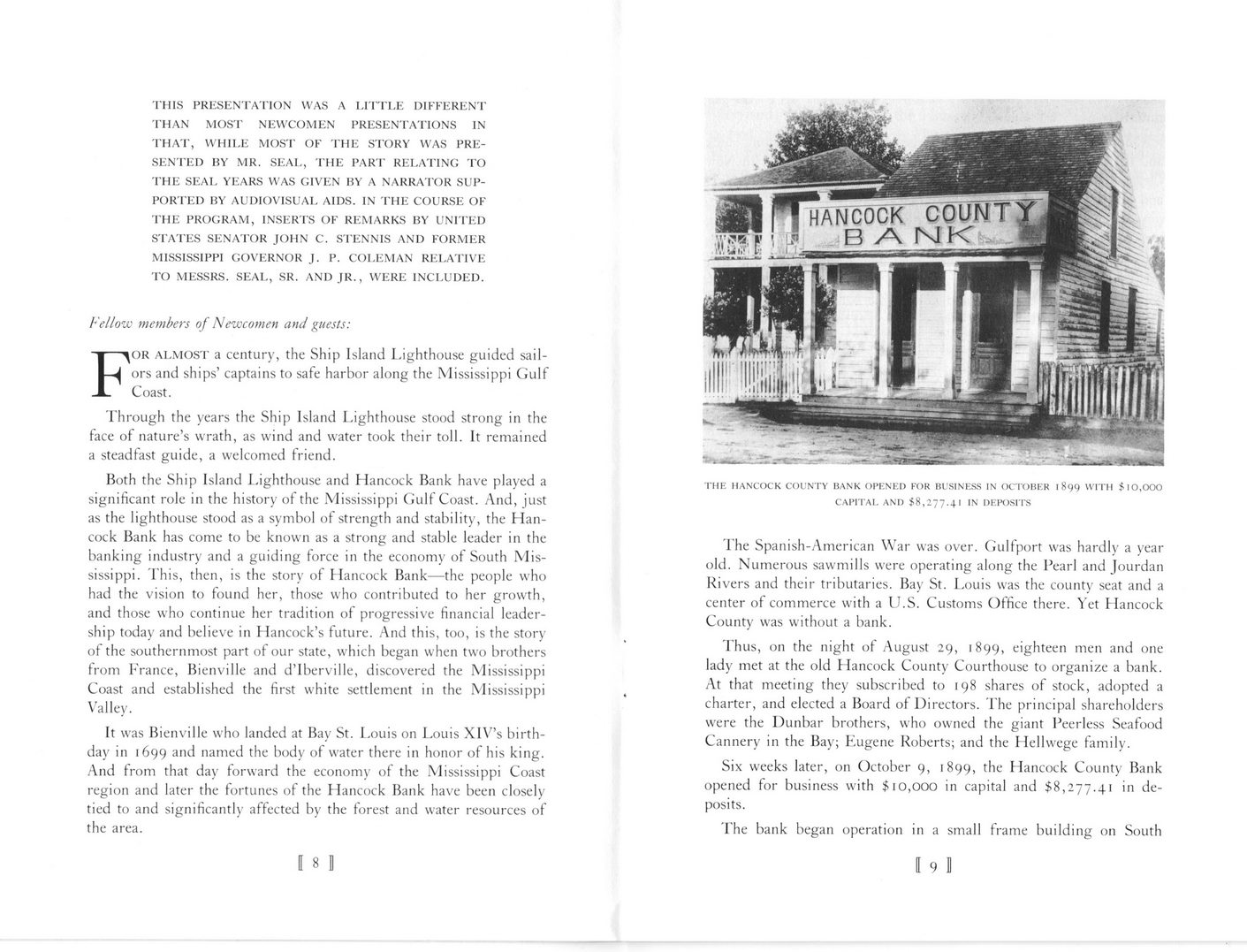This text was obtained via automated optical character recognition.
It has not been edited and may therefore contain several errors.
THIS PRESENTATION WAS A I-ITI'LE DIFFERENT THAN MOST NEWCOMEN PRESENTATIONS IN THAT, WHILE MOST OF I'HE STORY WAS PRESENTED BY MR. SEAL, I'HE PART RELATING TO I’HE SEAL YEARS WAS GIVEN BY A NARRATOR SUPPORTED BY AUDIOVISUAL AIDS. IN I'HE COURSE OF I'HE PROGRAM, INSERTS OF REMARKS BY UNI TED STATES SENATOR JOHN C. STENNIS AND FORMER MISSISSIPPI GOVERNOR J. P. COLEMAN RELATIVE TO MESSRS. SEAL, SR. AND JR., WERE INCLUDED. Fellow members of Newcomen and guests: For almost a century, the Ship Island Lighthouse guided sailors and ships’ captains to safe harbor along the Mississippi Gulf Coast. Through the years the Ship Island Lighthouse stood strong in the face of nature’s wrath, as wind and water took their toll. It remained a steadfast guide, a welcomed friend. Both the Ship Island Lighthouse and Hancock Bank have played a significant role in the history of the Mississippi Gulf Coast. And, just as the lighthouse stood as a symbol ol strength and stability, the Hancock Bank has come to be known as a strong and stable leader in the banking industry and a guiding force in the economy of South Mississippi. This, then, is the story of Hancock Bank—the people who had the vision to found her, those who contributed to her growth, and those who continue her tradition of progressive financial leadership today and believe in Hancock’s future. And this, too, is the story of the southernmost part of our state, which began when two brothers from France, Bienville and d’Ibervilie, discovered the Mississippi Coast and established the first white settlement in the Mississippi Valley. It was Bienville who landed at Bay St. I.ouis on Louis XIV’s birthday in 1699 and named the body of water there in honor of his king. And from that day forward the economy of the Mississippi Coast region and later the fortunes of the Hancock Bank have been closely tied to and significantly affected by the forest and water resources of the area. THE HANCOCK COUNTY BANK OPENED FOR BUSINESS IN OCTOBER I 899 WITH $10,000 CAPITAL AND $8,277.41 IN DEPOSITS The Spanish-American War was over. Gulfport was hardly a year old. Numerous sawmills were operating along the Pearl and Jourdan Rivers and their tributaries. Bay St. I.ouis was the county seat and a center of commerce with a U.S. Customs Office there. Yet Hancock County was without a bank. Thus, on the night of August 29, 1899, eighteen men and one lady met at the old Hancock County Courthouse to organize a bank. At that meeting they subscribed to 198 shares of stock, adopted a charter, and elected a Board of Directors. The principal shareholders were the Dunbar brothers, who owned the giant Peerless Seafood Cannery in the Bay; Eugene Roberts; and the Hellwege family. Six weeks later, on October 9, 1899, the Hancock County Bank opened for business with $10,000 in capital and $8,277.41 in deposits. The bank began operation in a small frame building on South

Hancock Bank Leo-Seal-Leading-The-Way-(1987)-05